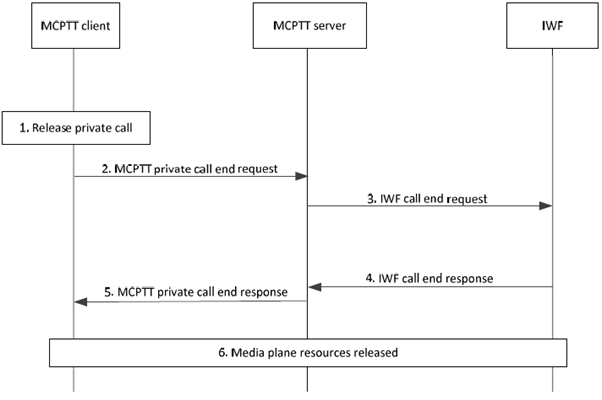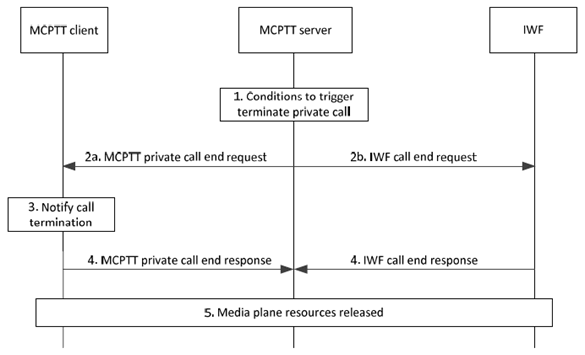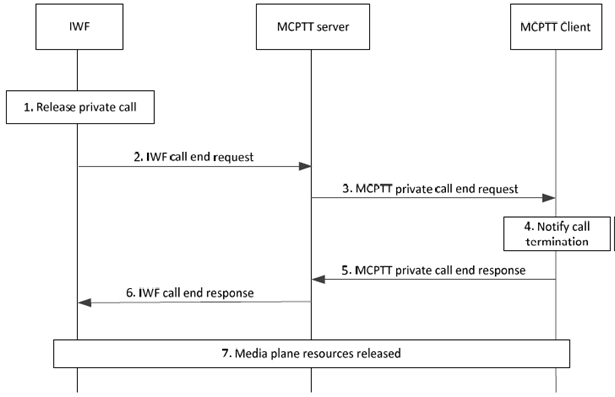Content for TS 23.283 Word version: 18.1.0
1…
10…
10.2…
10.2.2…
10.2.3…
10.3…
10.3.3…
10.3.3.7…
10.3.4…
10.3.4.4…
10.3.5…
10.3.5.8…
10.3.6…
10.3.7…
10.3.7.5…
10.3.8…
10.4…
10.4.4…
10.5…
10.5.7…
10.6…
10.6.2…
10.6.2.3…
10.6.3…
10.6.4…
10.7…
10.8…
10.11…
10.11.4…
10.12…
10.14…
10.15…
10.4.4 Private call release
10.4.4.1 MCPTT client initiated
10.4.4.2 MCPTT server initiated
10.4.4.3 LMR user initiated
10.4.5 Encryption of private calls
...
...
10.4.4 Private call release p. 98
10.4.4.1 MCPTT client initiated p. 98
The procedure describes the case where an MCPTT client requests release of an ongoing MCPTT private call (with or without floor control) that was established in either of the two commencement modes (manual or automatic). This subclause is based upon the subclauses for MCPTT private call release in subclauses 10.7.2.2.3.1 and 10.7.2.3.3 of TS 23.379.
Procedures in Figure 10.4.4.1-1 are the basic signalling control plane procedures for the MCPTT client initiating the release of an ongoing interworked private call.
Pre-conditions:
- The MCPTT user on the MCPTT client is already registered for receiving MCPTT service and is involved in a private call with an LMR user via the IWF with or without floor control and established either in manual or automatic commencement mode, as described in subclause 10.4.2 and subclause 10.4.3.

Step 1.
The user at the MCPTT client would like to release an ongoing interworked private call with the LMR user.
Step 2.
The MCPTT client sends an MCPTT private call end request towards the MCPTT server (via SIP core) for tearing down the private call with the other client.
Step 3.
The MCPTT server sends the corresponding IWF call end request towards the IWF, addressed to the MCPTT client ID specified in the original MCPTT private call end request.
Step 4.
The IWF acknowledges the IWF call end request with an IWF call end response sent towards the MCPTT server.
Step 5.
After receiving the MCPTT private call end request acknowledgement from the IWF, the MCPTT server generates an acknowledgement for the MCPTT client's MCPTT private call end request.
Step 6.
The MCPTT client and the IWF release all the media plane resources used for the private call. Further, if the private call was established with floor control, floor control resources are released and the MCPTT client cannot make further requests for floor control or send media.
10.4.4.2 MCPTT server initiated p. 99
The procedure describes the case where an MCPTT server terminates an ongoing interworked private call (with or without floor control) that was established in either of the two commencement modes (manual or automatic). The conditions causing the MCPTT server to terminate the call could include expiry of the MCPTT administrator configured maximum duration for MCPTT private calls or expiry of the maximum time permitted for an MCPTT private call without transmission/reception. This subclause is based upon the subclauses for MCPTT private call release in subclauses 10.7.2.2.3.2 and 10.7.2.3.3 of TS 23.379.
Procedures in Figure 10.4.4.2-1 are the basic signalling control plane procedures for the MCPTT server initiating termination of an ongoing interworked private call.
Pre-conditions:
- The MCPTT user on the MCPTT client is already registered for receiving MCPTT service and is involved in a private call with an LMR user via the IWF with or without floor control and established either in manual or automatic commencement mode, as described in subclause 10.4.2 and subclause 10.4.3.

Step 1.
Upon conditions to terminate call e.g., MCPTT administrator configured maximum duration for MCPTT private calls expiry or time out due to MCPTT private call without transmission/reception, the MCPTT server decides to initiate termination of an ongoing interworking private call between the MCPTT client and the LMR user.
Step 2a.
The MCPTT server sends an MCPTT private call end request towards the MCPTT client (via SIP core) for tearing down the private call.
Step 2b.
The MCPTT server sends a corresponding IWF call end request towards the MCPTT client identity associated with the LMR user
Step 3.
The MCPTT user at the MCPTT client is notified about the termination of the private call.
Step 4.
The MCPTT client and the IWF acknowledge the request.
Step 5.
The MCPTT client and the IWF release all the media plane resources used for the private call. Further, if the private call was established with floor control, floor control resources are released and the MCPTT client cannot make further requests for floor control or send media.
10.4.4.3 LMR user initiated p. 100
The procedure describes the case where either an LMR user or the LMR system is requesting to release an ongoing interworked private call (with or without floor control) and the call established in either of the two commencement modes (manual or automatic). This subclause is based upon the subclauses for MCPTT private call release in subclauses 10.7.2.2.3.1 and 10.7.2.3.3 of TS 23.379.
Procedures in Figure 10.4.4.3-1 are the basic signalling control plane procedures for the LMR user, via the IWF, initiating the release of an ongoing interworked private call.
Pre-conditions:
- The MCPTT user on the MCPTT client is already registered for receiving MCPTT service and is involved in a private call with an LMR user via the IWF with or without floor control and established either in manual or automatic commencement mode, as described in subclause 10.4.2 and subclause 10.4.3.

Step 1.
The LMR system would like to release an ongoing interworked private call with the MCPTT user.
Step 2.
The IWF sends an IWF call end request towards the MCPTT server for tearing down the private call with the MCPTT client.
Step 3.
The MCPTT server sends the corresponding MCPTT private call end request towards the MCPTT client specified in the original IWF call end request.
Step 4.
The MCPTT user is notified about the release of the private call.
Step 5.
The MCPTT client acknowledges the MCPTT private call end request.
Step 6.
After receiving the MCPTT private call end request acknowledgement from the MCPTT client, the MCPTT server generates an acknowledgement for the IWF's IWF call end request.
Step 7.
The MCPTT client and the IWF release all the media plane resources used for the private call. Further, if the private call was established with floor control, floor control resources are released and the MCPTT client cannot make further requests for floor control or send media.
10.4.5 Encryption of private calls p. 101
Private calls can use MC media encryption (see TS 33.180) between the IWF and the MCPTT client. A private call that uses an LMR vocoder may use LMR E2EE if the calling and called parties have previously been provisioned with the appropriate LMR E2EE keys.